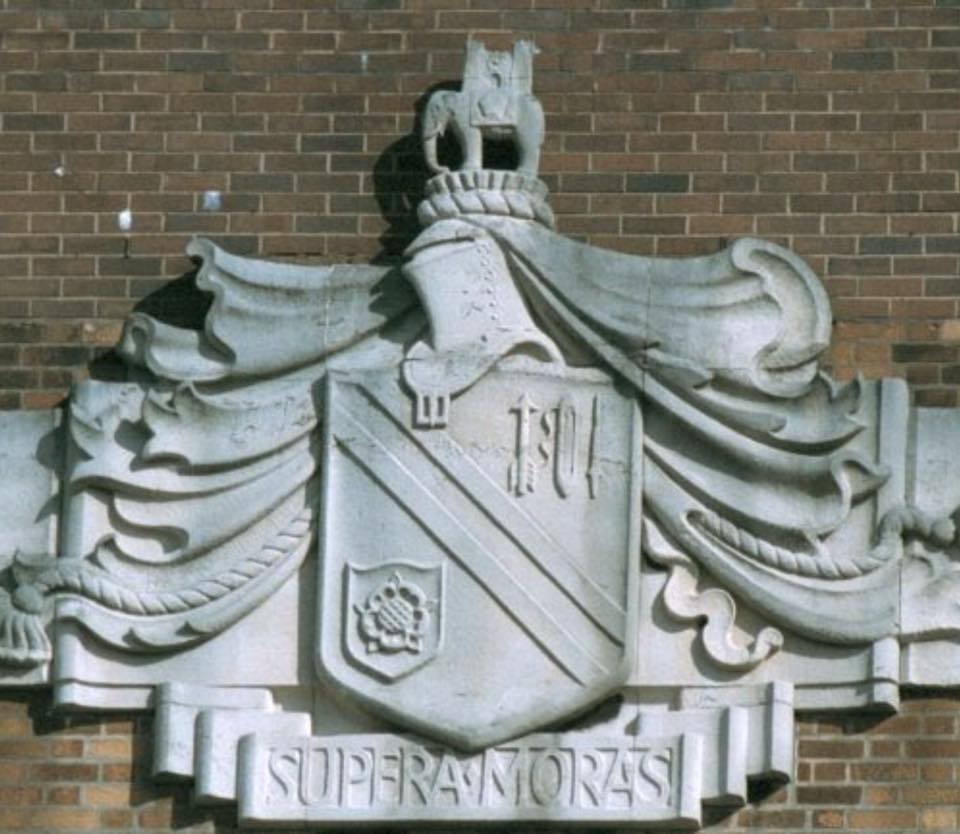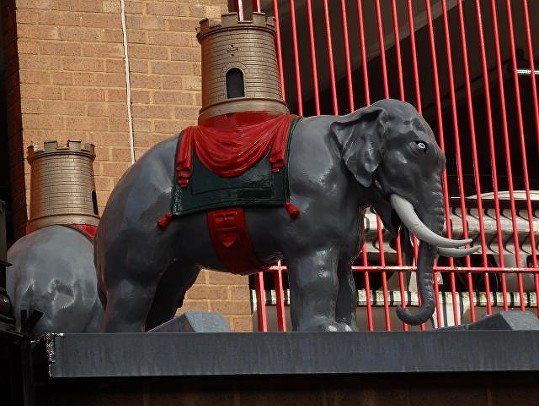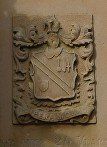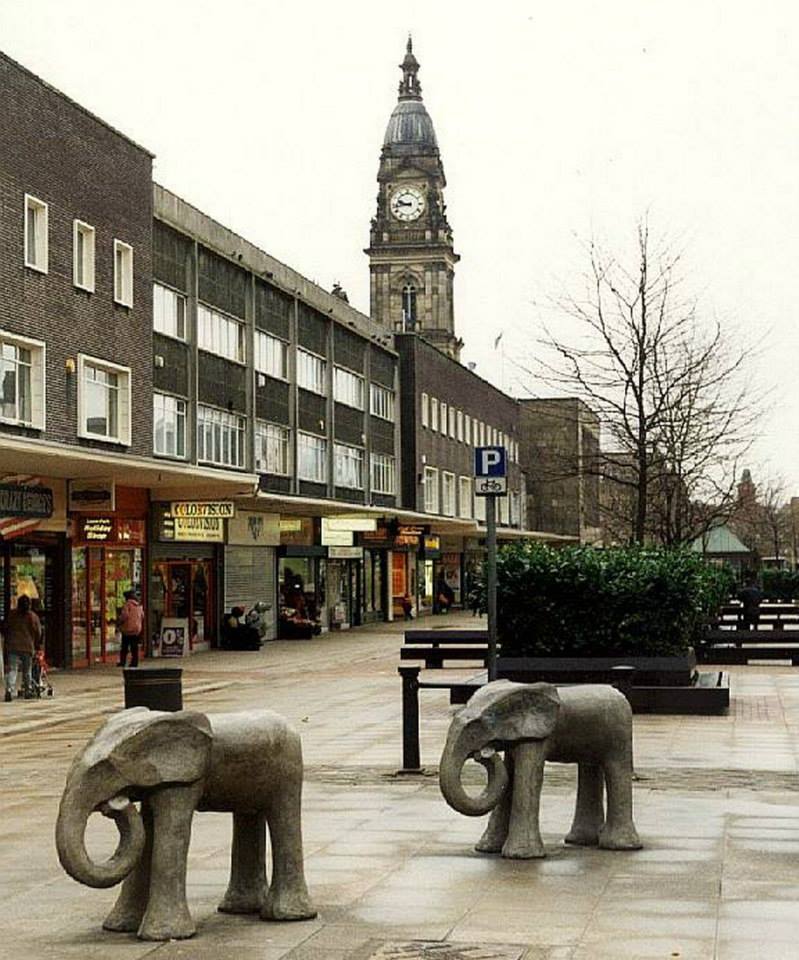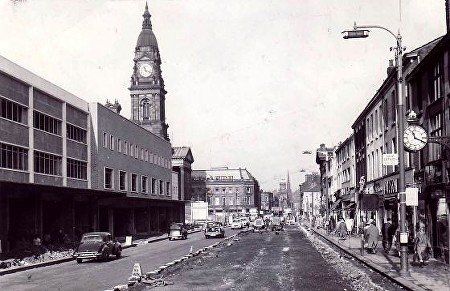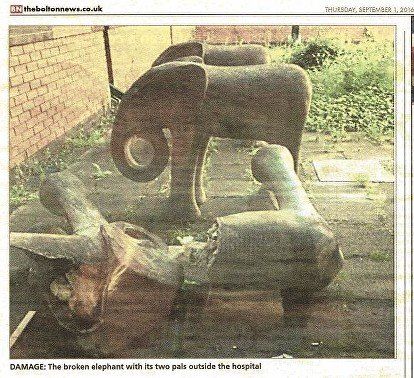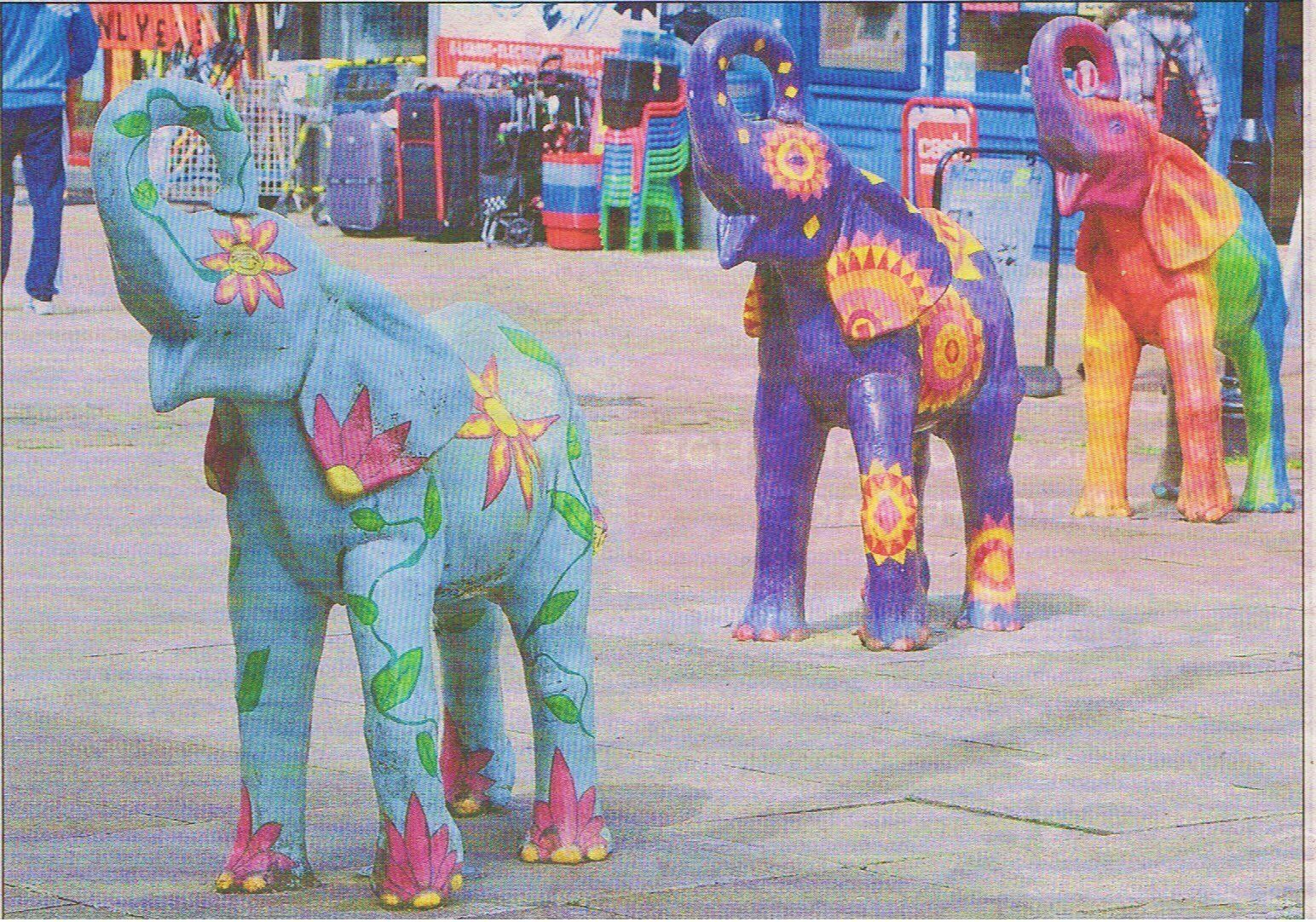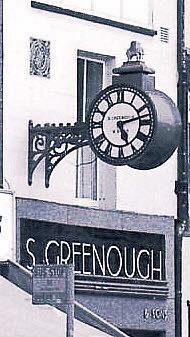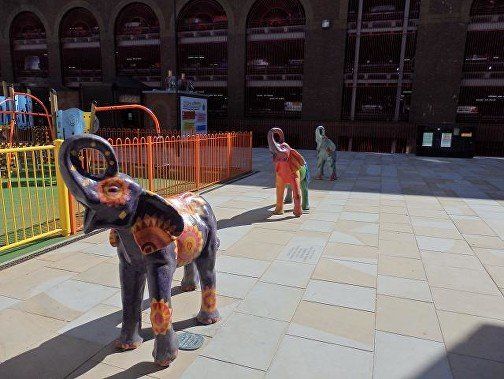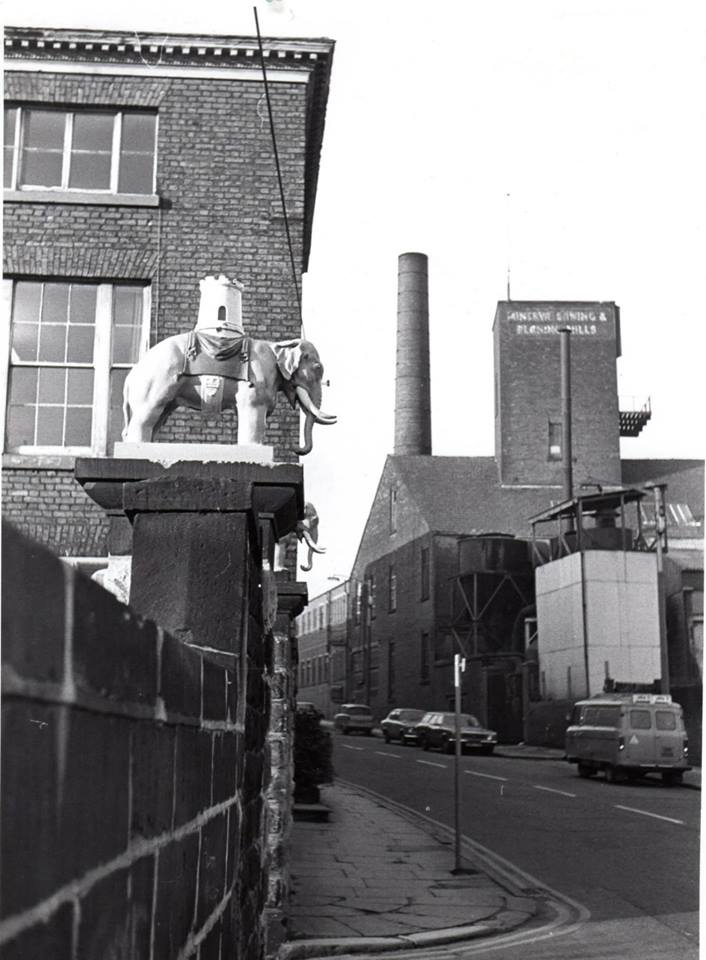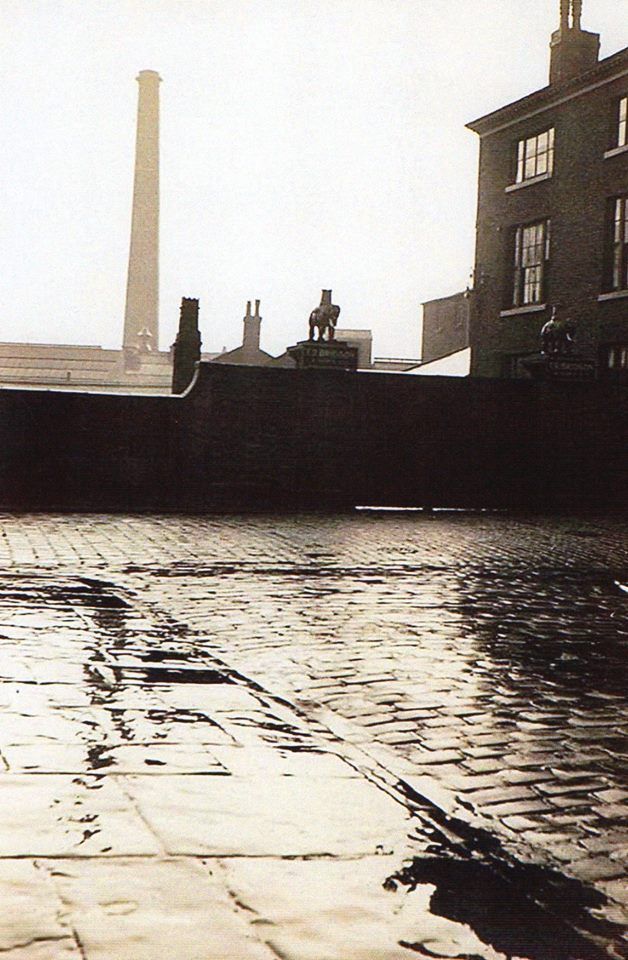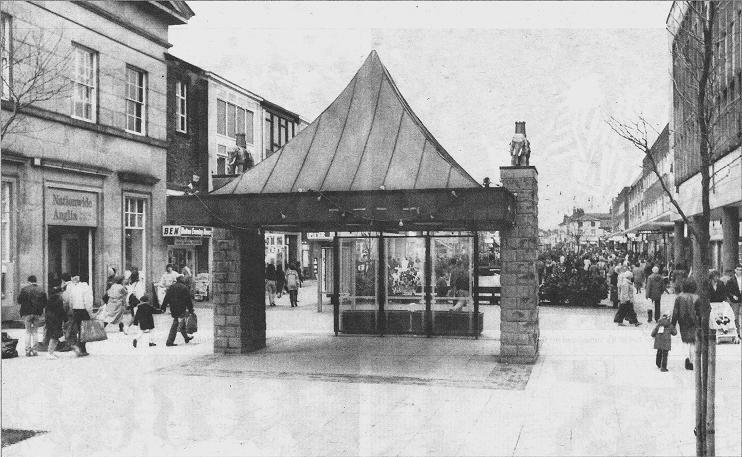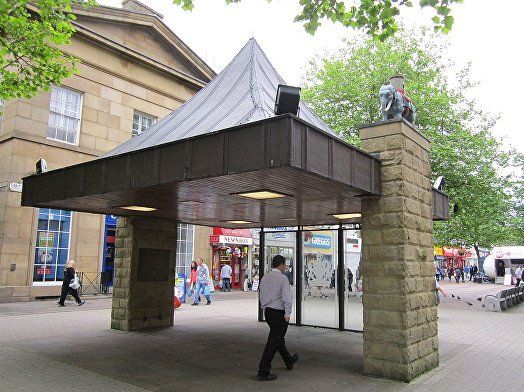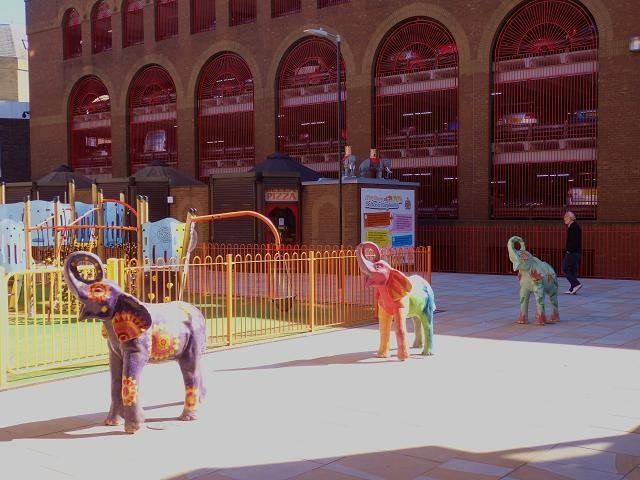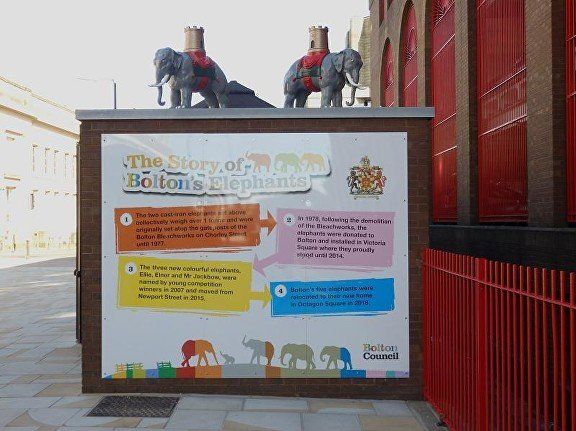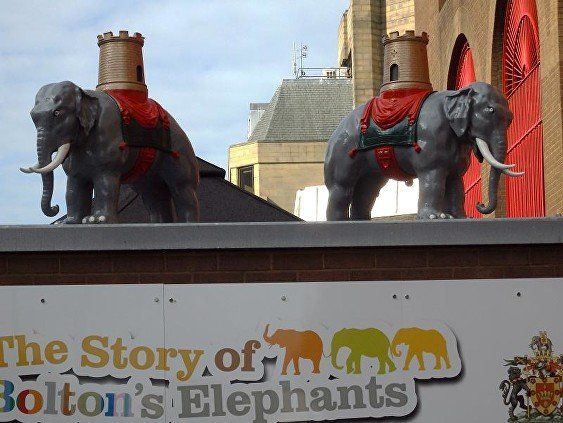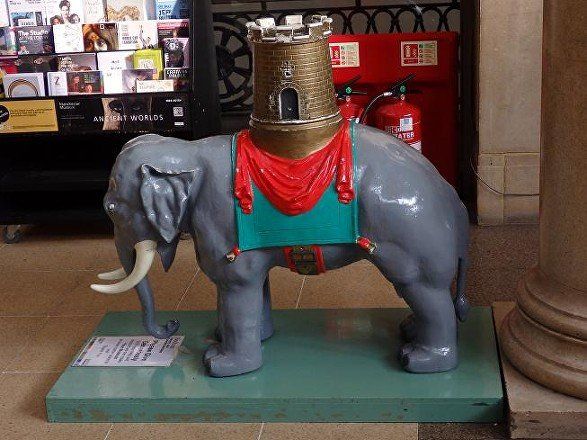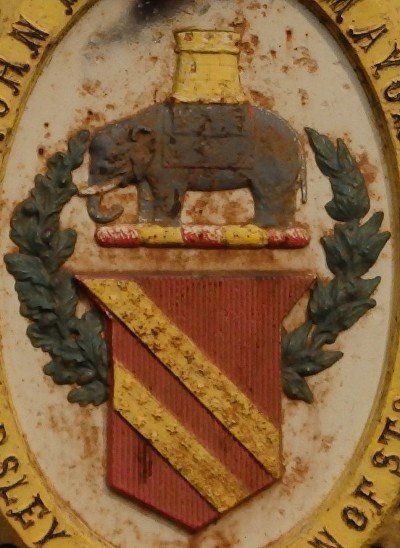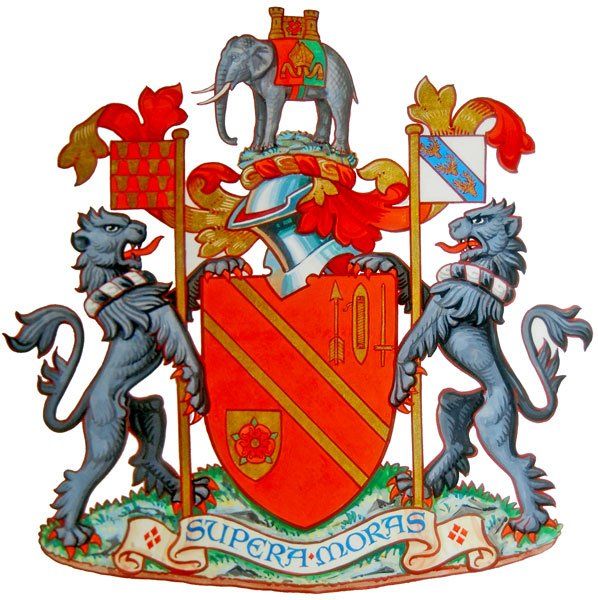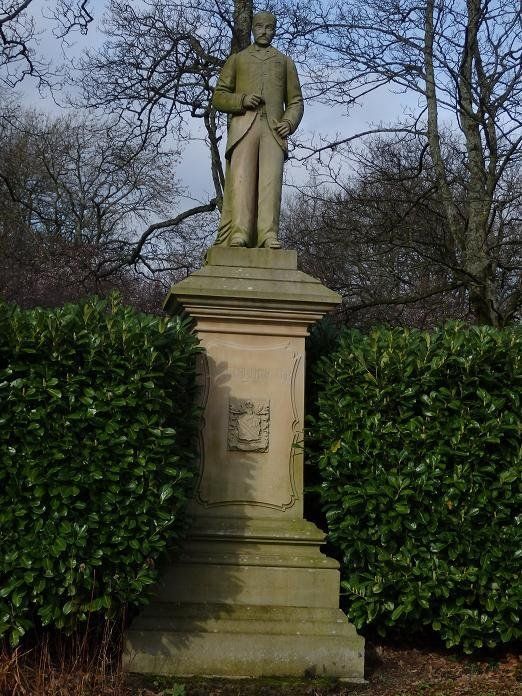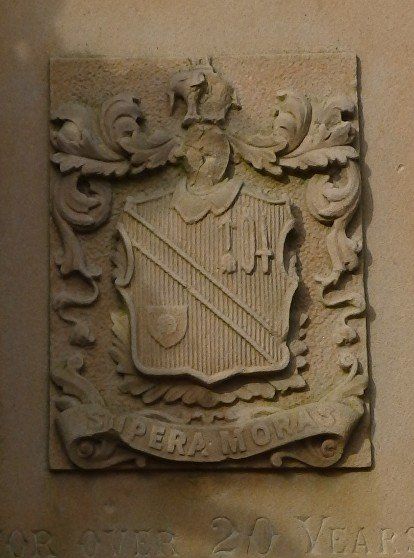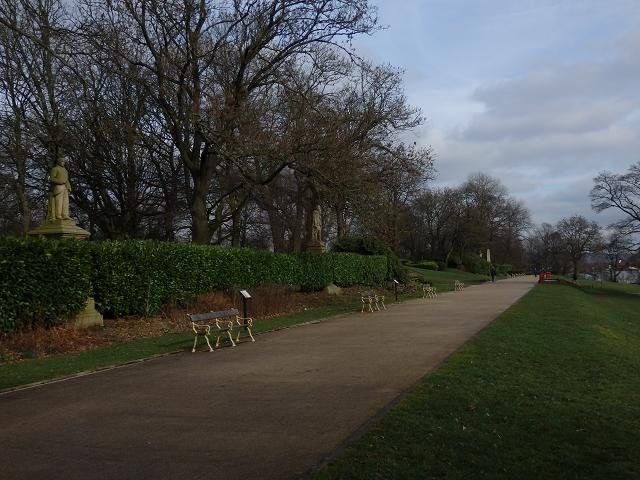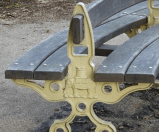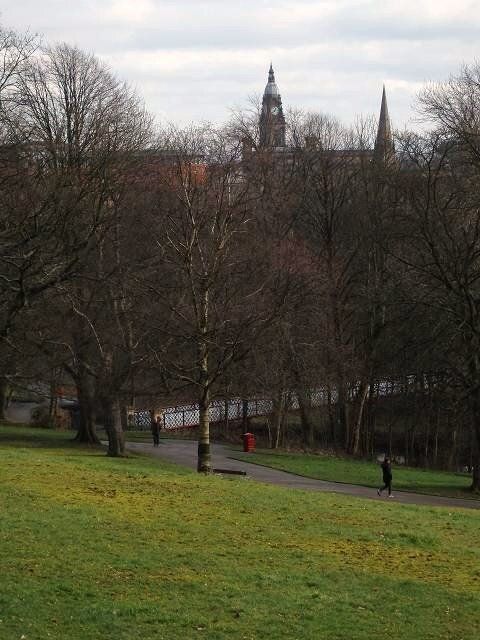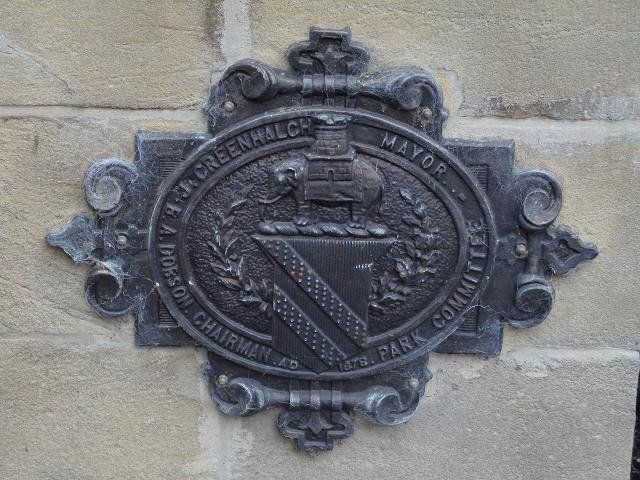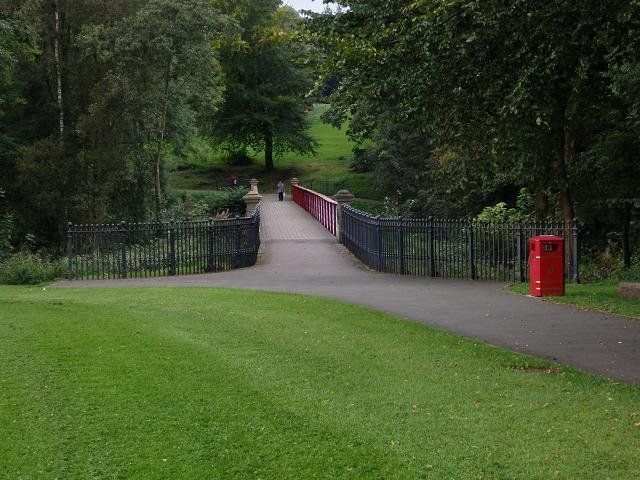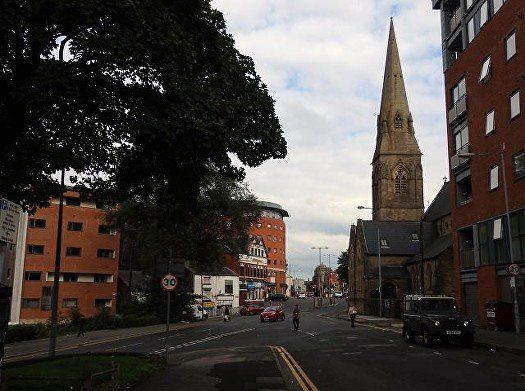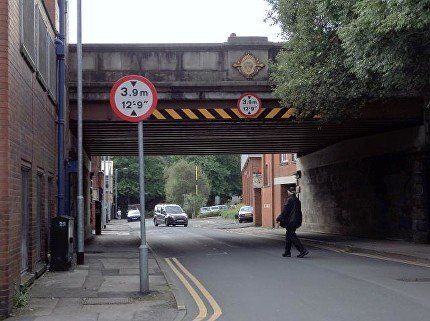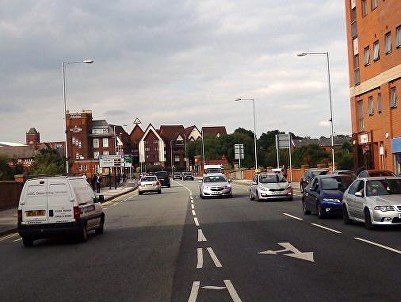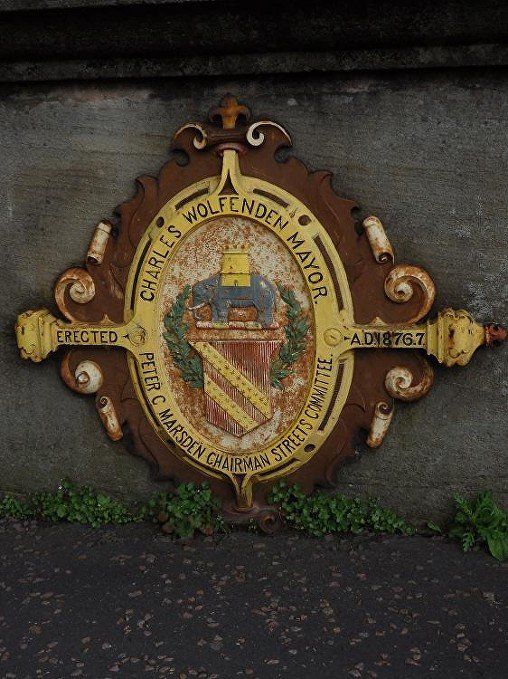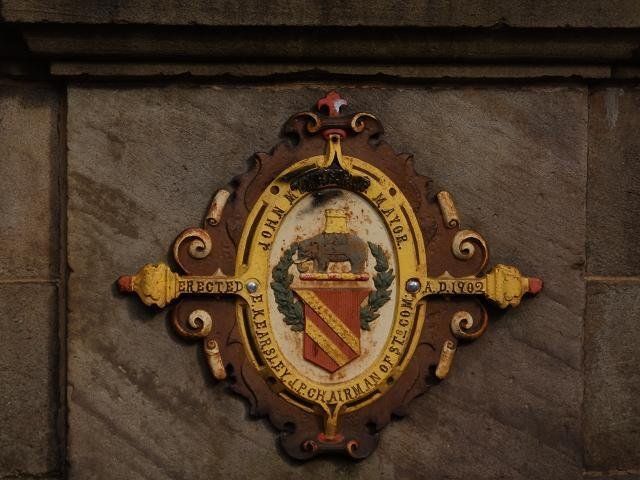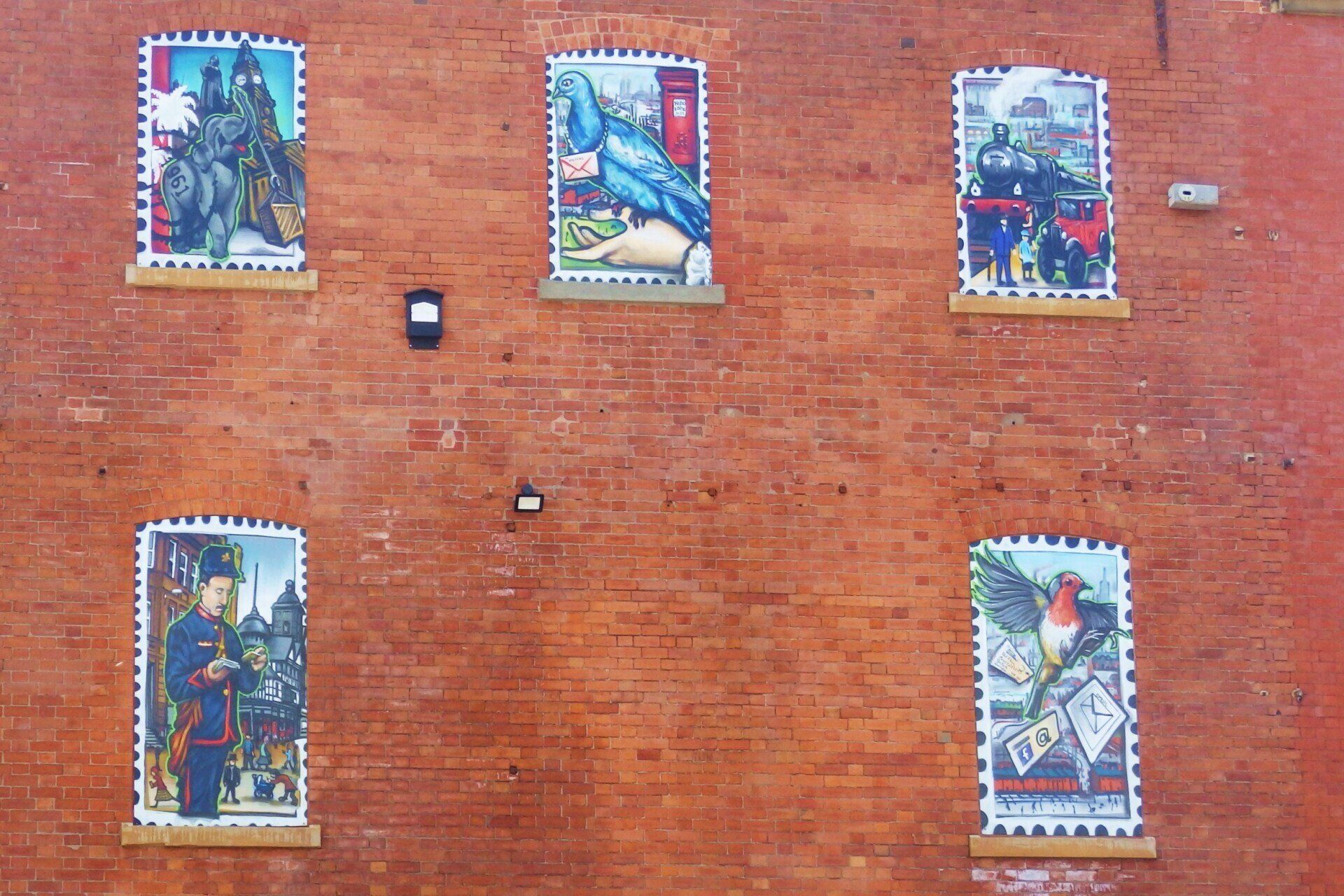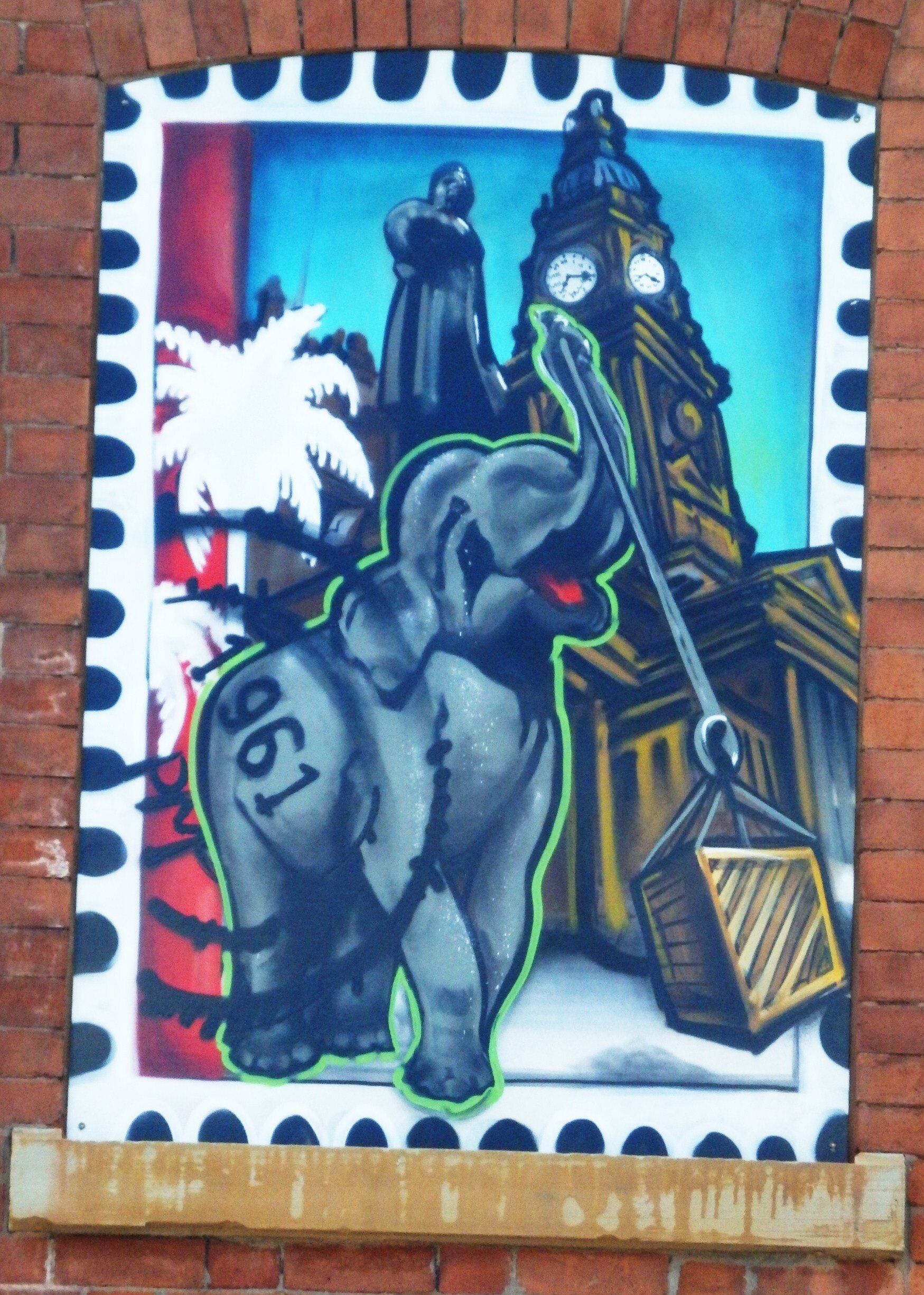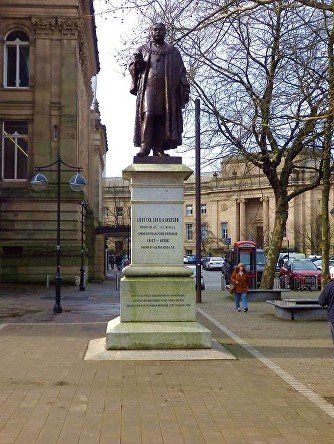We start with what were, for a time, the most well known and most familiar of our elephants, on Newport Street at its junctions with Great Moor Street, posted on facebook by David Whenlock.
While we are here just look at the other side of the street as it was in 1959. Most people knew of this clock, a favourite landmark – meet me under the clock – but look what is on top of it! Pity this is no longer there.
On the right - a close up of the Greenhough's clock with its elephant.
Those grey elephants were removed and after being missing for a little while, in 2007 they were put just outside a window of the main corridor at Royal Bolton Hospital. Sadly one of them which was already slightly damaged was broken in half while they were being moved to allow some building work. The Bolton News reported this in 2014. There is no report that anyone called 999.
Now a look at the more traditional elephants which were the inspiration for the ones in Newport Street. These were on the gateposts of Bridson’s Croft at the bottom of Chorley Street. These were once the most well known elephants in Bolton because you almost certainly would have passed them as you walked from the Infirmary into town.
These were made of cast iron and weigh more than half a ton each. They were removed in 1977 when that area was demolished and donated to the town by the then owners, William Kay Timber Importers and were put into storage somewhere.
When these pictures were seen on this site a little time ago, George Lomax sent this message: The elephant at Bridson's was knocked off its pillar around 1968 by a delivery lorry to Wm Kay light weight roofing division at Bridson's old works and penetrated the tyre of the lorry whose driver had to explain to his employer how an elephant tusk had punctured his front tyre. And I know just how heavy they are as I assisted in their removal.
This is where they appeared when they came back into public view.
The Marks and Spencer Charity Canopy was built in 1984 and the elephants took pride of place on the brick columns either side.
The canopy was demolished in 2014 and the elephants disappeared again for a little while
When I showed you the coloured elephants near the Octagon carpark a minute ago, I wonder if you noticed something behind them in the shadows. Well here is a less shadowy picture and you can see the new home of our cast iron elephants. Many people have criticised this as being inappropriate, our iconic elephants on the roof of a pizza kiosk! Pride of place on the Charity Canopy seemed a very good place to display them; this is perhaps less so.
(C)WDC May 2016
Three pictures of the elephants in their current location (C)WDC May 2016, Sept 2016, Sept 2016
There was a replica of one of these elephants up the stairs in the foyer of the library before the renovations in 2018/19. It was not here last time I visited. (C)WDC Sept 2016
So why elephants? The early origin is not quite clear but it seems that in the hey-day of the cotton industry when we were exporting finished cloth to India some weavers were stamping the end of their “bolts” with a picture of an elephant to indicate strength and reliability, an image and meaning that were very familiar in India.
Then in 1799 the elephant and castle appeared on the official stamp of the Clerk to the Board of Trustees of the town and was adopted as the town crest.
This is a rather simple crest, the elephant is a bit tubby, we have a branch of oak leaves on the left and a branch of other leaves on the right. The bottom leaf looks like a sycamore or maple but it looks more like a laurel wreath higher up. We note that the castle has a single turret.
Bolton became a County Borough in 1889 and in 1890 Major Otley Parry created a much more complex coat of arms. The elephant of course sits on top. It now has a castle with two turrets.
The elephant was probably kept because people expected it to be kept from the previous crest.
However it has also been stated that the elephant was included in honour of Mr T R Bridson, a former mayor who had seem service in the Indian army in Nepal. This Mr Bridson was of course the owner of the Chorley Street croft. (The elephants were put on his gateposts around1850-60 so before County Borough but after previous crest.)
But – this elephant has a blanket on which is depicted a bishop’s mitre! This seems to relate back some hundreds of years to when Bolton was part of the diocese of Mercia with its seat in Coventry. The city of Coventry created by the Lancastrian King Henry VI had an elephant as its symbol. Note that this elephant is standing on “a rocky moor”. The motto which means overcome delays is a pun on “upon the moors”.
The diagonals have been retained and to the left is the red rose of Lancashire. Above and to the right an arrow, recalling that archers from Bolton played a part at the Battle of Flodden in 1513 and two symbols of the cotton industry, a weaver's shuttle and a spindle from Samuel Crompton's spinning mule.
At the last major reorganisation of local authorities, the Metropolitan Borough of Bolton was formed from Bolton, Horwich, Westhoughton, Blackrod, Farnworth, Keardley, Little Lever and the southern part of Turton Urban District, that is - the villages of Bradshaw, Bromley Cross, Dunscar, Egerton and Harwood an area now known as South Turton. These eight townships are denoted by the eight Lancashire roses around the shield.
The main item is a pun on Bolton – the arrow is a BOLT and it is surrounded by, not a crown, but a palisade, a fence, a TUN. However one must wonder if the arrow is also a look back to the previous coat of arms. We still have the elephant with its twin turreted castle but the bishop’s mitre has disappeared leaving just the Lancastrian rose.
We now have a black lion copied from the previous arms and a red lion copied from the arms of Farnworth (which at one time represented the Hulton family). The left pennon clearly represents the cotton industry but the right pennon is a hornet which represents paper making. The mayor’s chain of office has similar insects on it but when we visited the mayor some years ago we were told that they were bees and it was simply B for Bolton.
This coat of arms was created in 1974 by N Ellis Tomlinson, M.A., F.H.S. in consultation with Michael Cresswell, LL.B. Bolton's Assistant Council Solicitor
Now we will have a walk across town spying out some more examples of Bolton’s elephants.
We start in Queen's Park on the esplanade where are statues of Benjamin Disraeli and a couple of people we have never heard of though they played important parts in Bolton's past. On the plinth of one of these statues is our first elephant, slightly worn after 124 years in the Bolton weather.
This is John Fielding. A plaque gives details of his life and achievements. The wording is reproduced at the foot of this page.
We remain on the esplanade for our next elephant.
At the end of the esplanade is what has been known by many generations as the pie crust. Within its circular parapet is a circular bench. The cast iron ends of the bench have mouldings of our elephant. The purist will rejoice that we have only a single turret though this seems inordinately large for that poor elephant to carry. Pictures 2,3,4,5 (C)WDC July 2020
Then we leave the esplanade and go down across the park to Dobson Bridge which was always the main access to the park, though these days, with the modern playground, the updated cafe and the carpark probably more people now go in from the bottom of Park Road.
To see a picture full size, click on it. Use < > X to navigate and exit.
Left - across the park to Dobson Bridge
Above - looking across the bridge from the Spa Road end, the traditional entrance to Queen’s Park. Dobson Bridge which was built in 1878, closed in 2003 because it had corroded and become unsafe. It was feared that the bridge would be demolished but repairs began 2009 as part of a multi-million pound refurbishment of the park (£500,000 for the bridge) and it was reopened 2010
Below left - And on the stone pillar there is our rather tubby elephant on the original coat of arms with the date 1878. J Greenhalgh, Mayor; B A Dobson Chairman of the Parks Committee.
The bridge was named after the chairman of the Parks committee at that time, Benjamin Alfred Dobson, a Bolton industrialist and benefactor whose statue is to the left of the town Hall. Mayor of Bolton 1898.
More on B A Dobson at the foot of the page.
Across Spa Road from Queens Park are the old electricity offices and generator hall, built in a corner of the gas works site.
"In the brick building behind the offices, Bolton's electricity was generated before the move to Back o' th' Bank. The foundation stone was laid by Alderman John Miles in 1893. On the 31st October 1894 high voltage alternating current was supplied to the central area of the town. A showpiece lamp was installed in the Town Hall Square which had until this time been lit by gas. This was the start of a massive adjustment to the supply of electricity. In 1898 it was decided to convert the tramway to electric operation and in hand with the needs of manufacturing, direct current rather than AC would be supplied." Warburton R. (1984) Electricity Generation in Bolton.
2. The large building with the "portholes" was the generator hall.
3 The main office door facing onto Spa Road.
4 decoration over the door
5 detail of the Bolton County Borough arms with the elephant.
We continue along Spa towards town and turn left over Marsden Road High Level Bridge.
Towards the far end where the bridge goes over Bark Street is a plate to commemorate the construction of the bridge – July 1876. Mayor, Charles Wolfenden; Peter C Marsden, Charirman of the Streets Committee.
If you go down to walk under the bridge you will see another plaque, disappointingly but not surprisingly identical to the one seen from on top of the bridge.
If you look over the wall from Marsden Road you look down onto St Edmund Street and the bridge over the River Croal also has its plaque with elephant. If anyone is not quite sure where this is, the stone building with the larger brick extension to the rear is the GPO.
Surprisingly this bridge was built AFTER the high level bridge, in 1902. John Myers, JP, Mayor; E Kearsley, JP, Chairman of the Streets Committee.
St Edmund's Street connecting to Pool Street looks like an ancient crossing point of the river and the bridge itself looks fairly old.
However the well-known map of 1824 shows no such through road. Pool Street stops short of the river at what looks like a small industrial area with, you guessed it, a pool.
The original Bolton Elephant walk took you from here up (the west part of) St George's Road because there was an elephant on the tile wholesaler's building. That building sadly is no more but we go instead to the rear of the GPO to see an elephant which only appeared in 2021.
On the picture just above from the St Edmunds Street bridge five windows could be seen on the back of the brick extension. These were later boarded up and in June 2021 were used for some Urban Art.
The GPO had closed a couple of years previously (see 22-Deansgate page) and conversion into apartments is almost complete..
The artwork, unveiled on 12 June 2021, was created by Kelzo aka Tony Brady and Entize aka Evan Barlow. The five windows represent various aspects of Bolton but all have at least a hint of this building's origin as the GPO.
Kelzo only recently completed a 50ft by 40ft mural in Saville Street which we will see later in our tour.
We reproduce just one of the "stamps" at this point because it features a Bolton elephant. We have not discovered the significance of the date 1961 on the "postmark".
On the next page we continue our elephant safari via Bolton Market.
John Fielding was born in 1849 at Redlaur near Blackburn, the son of a cotton worker. At the age of 12 he too became a cotton worker. In 1874 he became a fulltime trade unionist when he succeeded his father as secretary to the Self-Actor Minders’ Association. In November of that year he was appointed Secretary to the Bolton Trades’ Council. He was instrumental in uniting the two branches of spinning industry unionism in one organisation, the Operative Spinners’ Provincial Association, a union which was, according to the Bolton Journal, “second to none in the Kingdom for wealth and power.” The same paper praised “his indomitable energy, his great grasp of thought, his forceful character and his kindliness of disposition” which had “lifted his fellow workers from the chaotic weakness of disunion to the higher plane of united combined effort” and to the “proud position they now occupy in the industrial world”.
John Fielding died in 1894. Such were the achievements of this “uncrowned king of men” it was considered appropriate that his friends and admirers should get together to perpetuate his memory. The Operative Spinners’ Association voted £250 to Fielding’s wife and also contributed £105 as a nucleus of a memorial fund. A joint committee was then appointed consisting of members of the Spinners’ Association and the Bolton Trades Council. The sculptor, J W Bowden of Park Road, Bolton was appointed to create the life size statue, which cost £250.
The day of the unveiling, July 11th, 1896 would, according to the Bolton Journal, “live long in the memory of Boltonians as the one on which thousands of working men rose in the full strength of their industrial might to do honour to a man who had worked tirelessly for the benefit of his fellow workers.
J.T.FIELDING JP FOR OVER TWENTY YEARS / THE SECRETARY OF THE / OPERATIVE COTTON SPINNERS’ ASSOCIATION / AND UNITED TRADES COUNCIL / OF BOLTON AND DISTRICT / UNITY AND EQUITY WERE THE GUIDING PRINCIPLES OF HIS LIFE / ERECTED BY THE TRADE UNIONISTS AND PUBLIC OF BOLTON / AND PRESENTED TO THE BOROUDH 11TH JULY 1896
Sir Benjamin Alfred Dobson (1847-1898), textile machinery manufacturer and three times mayor of Bolton. He was born at Douglas on the Isle of Man, the son of a Belfast engineer. He was educated at Carlisle Grammar School and the Collegiate Institute in Belfast, where he studied engineering. He then joined the Belfast and Northern Counties Railway as an engineer before moving in 1871 to Bolton where he joined the family firm, Dobson and Barlow. He more than doubled the size of the firm, and by 1898 employed a workforce of over 5,000. Although the Bolton Review of 1897 declared that Dobson was "beloved" by his workpeople "for his geniality and considerate regard for their welfare," he resisted their attempts to challenge his authority. During a strike in 1887 he brought in new workers to defeat the strikers, and in 1897 strongly resisted the demands of the Amalgamated Society of Engineers.(1) In spite of this attitude, in 1890 his workers nevertheless presented him with illuminated addresses of congratulation, a silver punch bowl and a diamond bracelet for his wife Coralie. By 1897, the Bolton Review judged that Dobson, as a businessman, probably had "no superior in Bolton." In October 1878 he was made awarded the Legion D'honneur by the French government in recognition of his services to French industry. In 1874 he went into politics, being returned as Conservative Councillor, being re-elected in 1877. During this time he was chairman of the parks, and technical instruction committees. In November 1894 he was elected Mayor for the first time. Dobson was one of the moving spirits behind the transformation of the Mechanics' Institution into the Technical School, opened in 1892. Dobson was almost archetypically Victorian in its devotion to public life. He took an active interest in all civic affairs, holding, among other posts, Chairman of the Bolton Ironfounders Association, President of the Bolton Chamber of Commerce, Justice of the Peace for the district and the county, member of the board of Governors of Bolton Grammar School, honorary vice-president of the bolton Church of England Educational Institution, Churchwarden at St. James's, and Honorary Colonel of the 2nd Volunteer Battalion, Loyal North Lancashire Regiment. In addition, he published many technical papers on aspects of cotton spinning and engineering. He was also known in Bolton for throwing lavish mayoral parties at the Town Hall and at his private residence "Doffcockers."(2) He was knighted in 1897 and died on 4 March 1898, leaving a substantial estate.
The inscription on his statue reads as follows:
LIEUT. COL. SIR B. A. DOBSON KNIGHT V.D., J.P., C.E., M.I. MECH. E. CHEVALIER DE LA LEGION D'HONNEUR 1847-98 MAYOR OF BOLTON 1895, 6, 7, 8 ERECTED BY PUBLIC SUBSCRIPTION TO COMMEMORATE A USEFUL LIFE AND SERVICE TO THE TOWN OF BOLTON AND UNVEILED BY MR. ALDERMAN NICHOLSON, J.P. 17TH FEBRUARY 1900.
